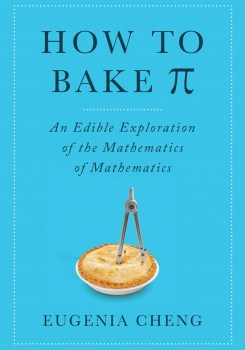How Math is Like Baking: You Just Need a Recipe
An excerpt from “How to Bake Pi” by Eugenia Cheng.
The following is an excerpt from How to Bake Pi: An Edible Exploration of the Mathematics of Mathematics, by Eugenia Cheng. Listen to SciFri on May 8, 2015, to hear Cheng talk more about practical math applications.
Pie: Abstractions as Blueprints
Cottage pie, shepherd’s pie, and fisherman’s pie are all more or less the same—the only difference is the filling that is sitting underneath the mashed potato topping. Fruit crisp is also very similar—you don’t really need a different recipe for different types of crisp, you just need to know how to make the topping. Then you put the fruit of your choice in a dish, add the topping, and bake it.
Another favorite of mine is upside-down cake. You put the fruit in the bottom of the cake pan, pour the cake batter on top, and after baking it you turn it out upside-down so that the fruit is on top. For extra effect you can put melted butter and brown sugar on the bottom of the cake tin first, to caramelize the fruit a bit. Of course, this works better with some fruit than others: bananas, apples, pears, and plums work well, grapes less well. Watermelon would be terrible. The same is true for crisp. Watermelon crisp? Probably not.
Savory tarts and quiches also follow a general pattern. You bake an empty pastry shell, put in some filling of your choice, and then top it up with a mixture of egg and milk or cream before baking it again. The filling could be bacon and cheese, or fish, or vegetables—whatever you feel like.
In all these cases the “recipe” is not a full recipe but a blueprint. You can insert your own choice of fruit, meat, or other fillings to make your own variations, within reason.

This is also how math works. The idea of math is to look for similarities between things so that you only need one “recipe” for many different situations. The key is that when you ignore some details, the situations become easier to understand, and you can fill in the variables later. This is the process of abstraction.
As with the watermelon crisp, once you’ve made the abstract “recipe” you will find that you won’t be able to apply it to everything. But you are at least in a position to try, and sometimes surprising things turn out to work in the same recipe.
Excerpted with permission from How to Bake Pi: An Edible Exploration of the Mathematics of Mathematics by Eugenia Cheng. Available from Basic Books, a member of The Perseus Books Group. Copyright © 2015.
Dr. Eugenia Cheng is Scientist in Residence at the School of the Art Institute of Chicago and author of several books, including The Art of Logic in an Illogical World (Basic Books, 2018) and Is Math Real?: How Simple Questions Lead Us to Mathematics’ Deepest Truths (Basic Books, 2023).